Regulatory frameworks grow more complex each year, spanning multiple jurisdictions and requiring increasingly detailed documentation. What once required a simple checklist now demands comprehensive audit trails, risk assessments, and continuous monitoring. Meanwhile, the penalties for non-compliance have become severe enough to threaten operational licenses, trigger massive fines, and destroy carefully built reputations.
This complexity explains why more organizations are turning to dedicated compliance management software. Rather than relying on fragmented systems and human memory, these tools create structured approaches to regulatory obligations. They automate the mundane work of deadline tracking while providing the documentation and oversight that modern compliance requires.
This guide explores what regulatory compliance software actually does, why it has become essential for many organizations, and how to choose a solution that fits your specific needs. We’ll examine the key functions these tools provide, review popular solutions currently available, and walk through a practical selection process that can help you avoid costly mistakes—both in compliance and in software purchases.
What Is Regulatory Compliance Software, and Why Do You Need One?
Regulatory compliance management represents a systematic approach to keeping organizational activities aligned with both internal policies and external regulatory requirements. This includes industry standards, legislation, and the expectations of auditors and regulators who oversee your sector.
Think of compliance management as creating a reliable framework where nothing important gets overlooked. Every requirement gets documented, every deadline gets tracked, and every responsible party knows exactly what they need to accomplish and when.
Regulatory compliance software takes this systematic approach and automates much of the heavy lifting. These software solutions handle the tedious work of tracking regulatory obligations, assigning tasks to the right people, monitoring compliance status, collecting evidence, and generating the reports that regulators expect to see.
The software essentially creates structure around regulatory information that might otherwise exist in scattered emails, shared drives, and individual team members’ heads. It assigns clear responsibilities, establishes checkpoints with automatic reminders, and maintains the documentation trail that internal and external audits require.
Consider the practical tasks that compliance software typically handles:
- Monitoring deadlines for report submissions and audit preparations
- Assigning responsible individuals and tracking task completion status
- Storing regulations and policies with proper version control
- Integrating with document management systems and data repositories
- Regularly checking for updates to existing regulations and new requirements
| Task category | Example activities | Benefit |
| Deadline monitoring | Report submissions, audit prep reminders | Prevents missed deadlines |
| Task assignment & tracking | Assigning responsibilities, tracking task completion | Accountability & transparency |
| Document management | Storing policies, version control | Easy access, reduces confusion |
| Regulatory updates | Monitoring changes to laws/standards | Maintains up-to-date compliance |
| Integration | Sync with document/data management systems | Reduces duplication/errors |
👉Is there any difference between regulatory compliance software and regulatory compliance management software? Regulatory compliance software and regulatory compliance management solution are essentially the same thing, with the terms used interchangeably in the market. The word “management” is sometimes added to emphasize that these tools don’t just track compliance requirements but actively help organizations manage the entire compliance process from planning to execution to reporting.
Why regulatory compliance software matters
The consequences of regulatory non-compliance extend far beyond simple inconvenience. Organizations face increasingly severe penalties for compliance failures, making prevention essential rather than optional.
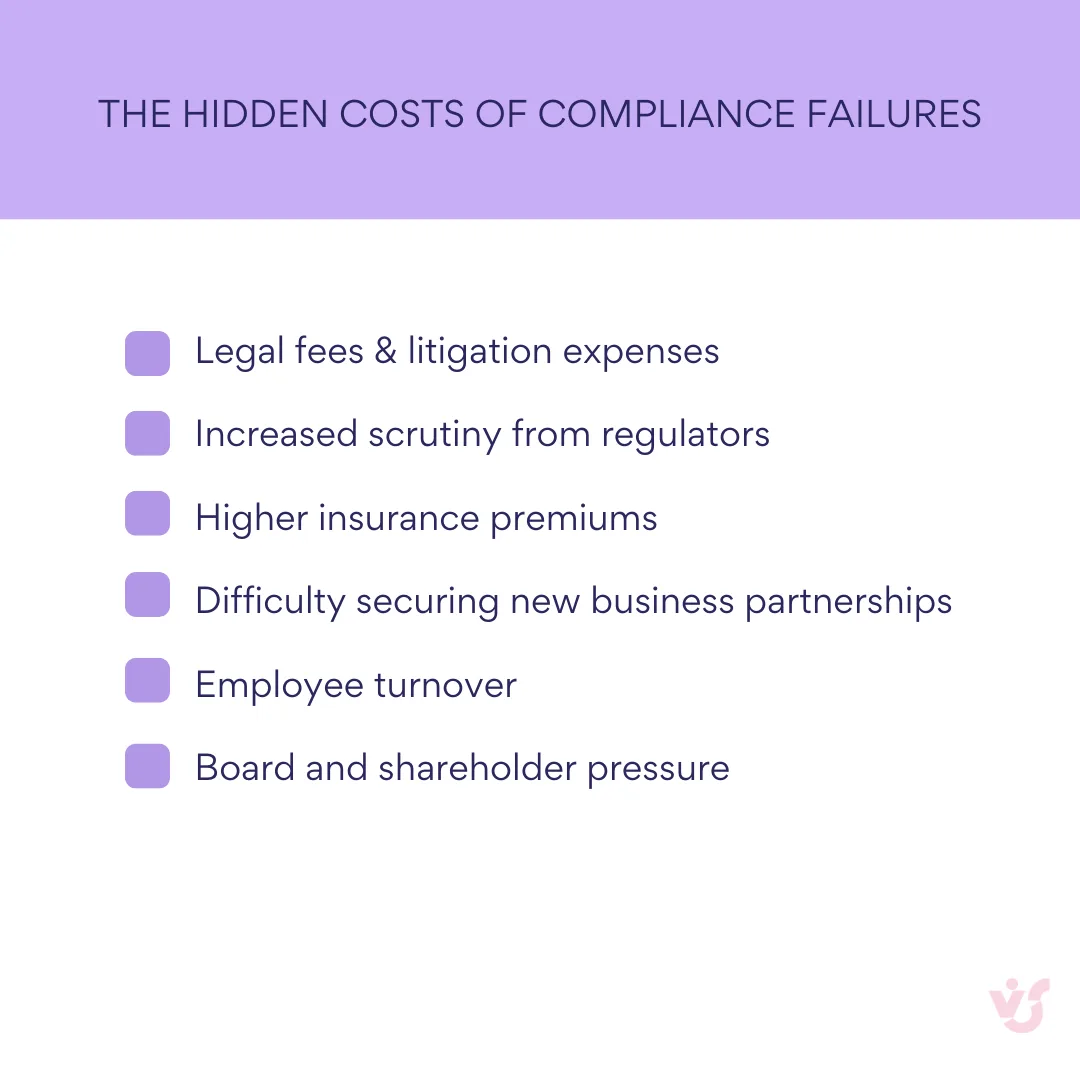
Financial sanctions represent the most immediate threat. Regulatory fines can reach millions of dollars, particularly in sectors like banking and healthcare where consumer protection is paramount. Lost contracts often follow, as clients become hesitant to work with organizations that demonstrate poor compliance practices.
Legal consequences can prove even more damaging. Regulatory violations frequently trigger lawsuits, and in severe cases, regulators may block business activities entirely until compliance is restored. Some organizations lose their operating licenses, effectively ending their ability to function in their chosen markets.
Reputation damage, though harder to quantify, often proves most costly in the long term. News of compliance failures spreads quickly, particularly in professional networks where trust is essential. Customers, investors, and business partners may reevaluate their relationships with organizations that appear unable to manage basic regulatory requirements.
Digital compliance tools address these risks by minimizing the human factors that cause most compliance failures. They reduce reliance on individual memory and manual tracking systems that inevitably break down under pressure.
These tools provide transparency that makes compliance status visible across the organization, enabling proactive problem-solving rather than reactive damage control. They distribute responsibility clearly across departments and roles, eliminating the confusion that often leads to missed deadlines.
Most importantly, they create predictable processes that reduce compliance incidents. When everyone knows what needs to happen when, and automated systems ensure nothing gets forgotten, organizations can focus on their core business rather than constantly firefighting compliance issues.
The tools also simplify interactions with external auditors by providing the documentation and audit trails that regulatory reviews require. Rather than scrambling to reconstruct compliance activities after the fact, organizations can provide real-time evidence of their compliance efforts.
Who needs regulatory compliance software
Medium and large organizations operating in highly regulated industries represent the primary market for compliance software. The complexity of modern regulatory environments makes manual compliance management increasingly impractical as organizations grow.
Financial sector organizations—banks, insurance companies, investment firms—face some of the most demanding compliance requirements. Regulations like Sarbanes-Oxley, Basel III, and various data protection laws create overlapping obligations that require sophisticated tracking and reporting capabilities.
Healthcare and pharmaceutical organizations must navigate equally complex requirements. Clinical labs, medical device manufacturers, hospitals, and pharmaceutical companies deal with FDA regulations, HIPAA privacy requirements, and various quality standards that demand meticulous documentation and regular reporting.
Energy and telecommunications companies operate under sector-specific regulations that vary significantly by jurisdiction. These organizations often need compliance software that can handle multiple regulatory frameworks simultaneously.
Government agencies and their contractors face unique compliance challenges. Grant requirements, public sector regulations, and transparency obligations create documentation demands that manual systems struggle to meet.
Educational institutions, particularly universities with research programs, must manage compliance across multiple domains—student privacy, research ethics, financial aid regulations, and workplace safety requirements.
International organizations face the additional complexity of varying regulations across different countries and jurisdictions. What satisfies regulators in one market may be insufficient in another, requiring software that can manage multiple compliance frameworks simultaneously.
Organizations that undergo regular audits, receive government grants, or must publish detailed activity reports find that compliance software pays for itself by reducing the time and effort required for these activities.
Companies whose compliance requirements are built into service level agreements or contracts with large clients often discover that their business relationships depend on their ability to demonstrate consistent compliance practices.
Key Functions of Regulatory Compliance Tools
Modern compliance tools handle the coordination challenges that make regulatory management so difficult when attempted manually. Understanding these core functions helps clarify why organizations invest in dedicated software rather than trying to manage compliance through general-purpose tools like spreadsheets or project management platforms.
| Function | Description |
| Centralized regulation management | Single repository for requirements & policies |
| Compliance calendar & visualization | Visual timelines and scheduling of milestones |
| Automated notifications & reminders | Alerts for deadlines and status changes |
| Standardized checklists & verification | Ensures consistent, auditable task execution |
| Risk management & monitoring | Prioritizes high-risk compliance items |
| Integration with corporate systems | Connects to ERP, CRM, Microsoft 365, etc. |
| Reporting & audit trail generation | Readily produces reports and evidence |
Centralized management of regulatory requirements, policies, and procedures
Compliance information tends to scatter across an organization like seeds in the wind. Regulations live in one system, internal policies in another, procedures in shared drives, and updates arrive through various channels—regulatory websites, industry newsletters, legal advisors, and conference presentations.
Compliance tools create a single digital repository for all applicable regulations, standards, internal policies, and operational instructions. This centralization eliminates the information fragmentation that leads to missed updates and inconsistent interpretations. Everyone accesses the same current version of requirements, reducing confusion and ensuring consistent application across departments.
Organizations with multiple divisions face particular challenges keeping local and global requirements synchronized. A pharmaceutical company, for instance, must track FDA requirements alongside European Medicines Agency standards, state-level regulations, and internal quality policies. Centralized management ensures that changes in any requirement category get communicated to all relevant stakeholders.
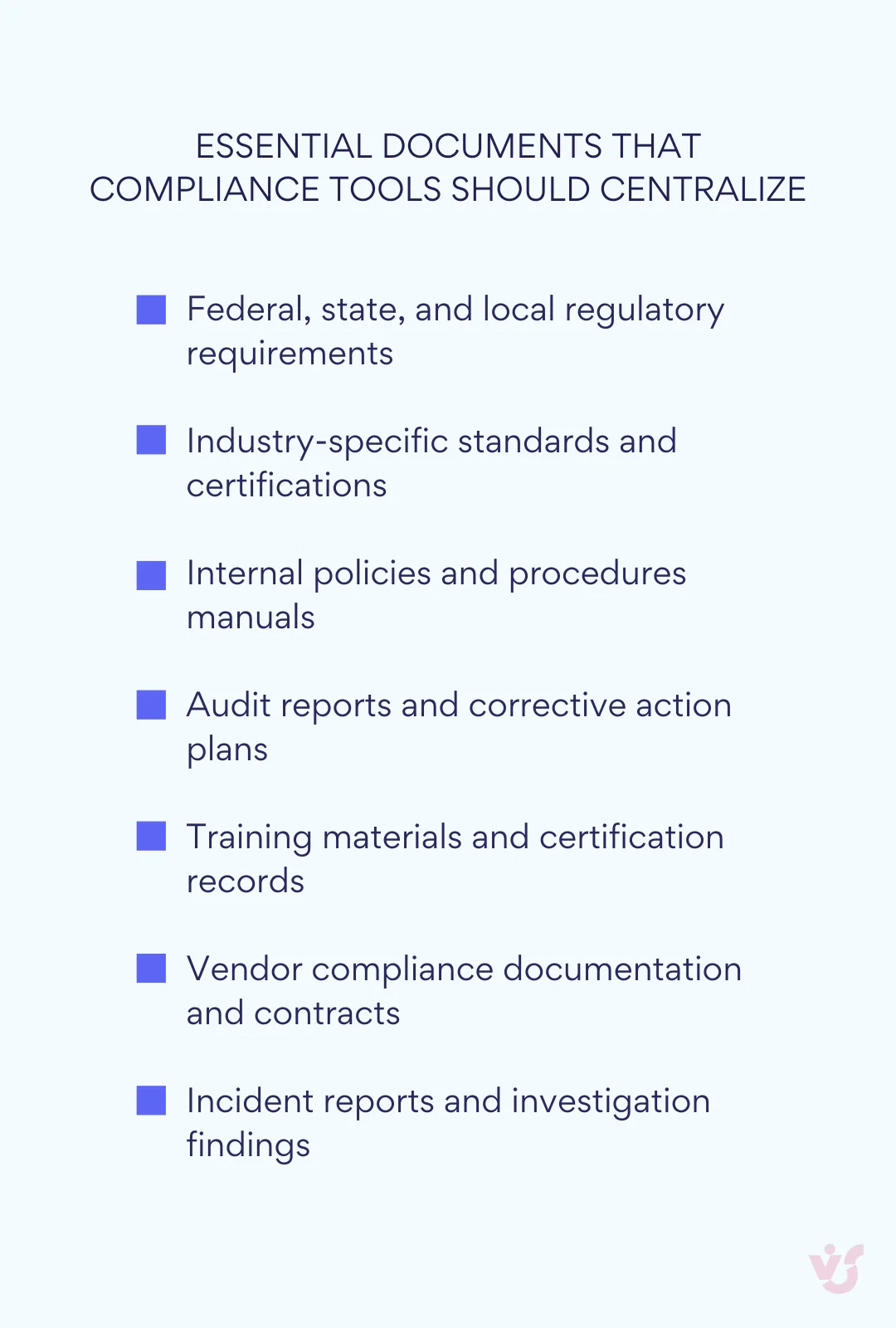
Planning and visualizing compliance milestones
Regulatory calendars often resemble air traffic control schedules—multiple moving parts that must coordinate precisely to avoid disasters. Compliance tools help organizations build clear timelines for regulatory events, from routine quarterly reports to major audit preparations.
Visual planning interfaces show the overall compliance workload at a glance. Calendar views reveal potential conflicts where multiple deadlines cluster together. Timeline charts help teams understand how different compliance activities connect and depend on each other. Dashboard views provide executives with high-level oversight while allowing detail access for operational teams.
These visualization capabilities prove particularly valuable for organizations managing:
- Reporting deadlines that vary by jurisdiction or business unit
- Scheduled and unscheduled audit preparations
- Internal compliance reviews and assessments
- Implementation stages for new security policies or ethical guidelines
Automatic notifications and reminders
Human memory fails under pressure, and busy professionals often juggle dozens of priorities simultaneously. Compliance violations frequently occur not from deliberate non-compliance, but from simple forgetfulness—missed deadlines, incomplete steps, overlooked documents.
Modern compliance solutions eliminate this human factor through intelligent notification systems. Employees receive reminders through their preferred communication channels—Microsoft Teams, email, or push notifications—when important deadlines approach. These systems can escalate notifications, sending initial gentle reminders weeks in advance, then more urgent alerts as deadlines near.
Smart notification systems consider individual work patterns and preferences. Some team members prefer daily digest emails, others want immediate notifications for high-priority items. The best systems adapt to these preferences while ensuring critical information never gets missed.
Compliance checklists and requirement verification
Regulatory requirements often involve complex multi-step processes that must be completed in specific sequences. A financial institution’s quarterly reporting might require data collection, internal review, external validation, executive approval, and final submission—with specific documentation requirements at each stage.
Compliance tools create standardized checklists for these processes, ensuring consistent execution regardless of who handles the work. Each regulatory event gets its own mandatory action sequence that responsible employees complete step by step. This standardization proves essential in industries where requirements repeat regularly—quarterly reporting cycles, annual recertifications, or ongoing counterparty verifications.
Checklists also simplify subsequent audits by providing clear evidence of completed work. Auditors can review exactly what was done, when, and by whom, rather than trying to reconstruct activities from scattered documentation.
Risk management and compliance monitoring
Effective compliance management requires understanding not just what needs to be done, but which requirements carry the highest risks if missed. Compliance tools integrate risk management capabilities that help organizations prioritize their efforts appropriately.
Risk classification features allow organizations to categorize compliance requirements by criticality level. High-risk items—those with severe penalties or short deadlines—receive enhanced monitoring and more frequent status updates. Medium and low-risk items get tracked but with less intensive oversight.
Responsibility assignment ensures that each risk category has designated owners for monitoring and mitigation activities. Risk tracking capabilities monitor how compliance risks change over time, identifying trends that might indicate systemic problems or improving performance.
Advanced systems provide automatic alerts when risks exceed specified parameters or when control processes show signs of breakdown. This proactive approach helps organizations address compliance problems before they escalate into violations.
Integration with corporate systems
Compliance cannot exist in organizational isolation. Most compliance activities require data from other business systems—financial information from ERP systems, customer data from CRM platforms, document storage from SharePoint repositories.
Modern compliance solutions support extensive integration capabilities, connecting with:
- ERP systems for budget controls and financial compliance monitoring
- CRM systems for customer due diligence and relationship management compliance
- Microsoft 365 ecosystem (Teams, SharePoint, Outlook) for document management and communication
- Calendar applications where compliance deadlines and review meetings get scheduled
These integrations reduce manual data entry, minimize duplication errors, and ensure that compliance activities stay synchronized with broader business operations. When changes occur in source systems, compliance tools can automatically update relevant tracking and reporting.
Report generation and audit preparation
Every compliance program eventually faces the question: “Can you prove you did what you said you’d do?” Compliance tools excel at generating the detailed documentation that answers this question convincingly.
Comprehensive reporting capabilities show exactly who completed which tasks, when work was finished, what documents were submitted, and which items remain outstanding. This level of detail proves invaluable during external audits, but also supports internal control processes, tender preparations, and certification activities like ISO, HIPAA, or SOC 2 compliance.
Report generation features typically offer multiple output formats and distribution options. Reports can be automatically generated on schedules and sent to designated email addresses or SharePoint folders. Custom report templates allow organizations to match specific regulatory or internal reporting requirements.
Compliance evidence collection and audit trails
Regulatory compliance increasingly requires not just completing required activities, but proving those activities were completed properly. Compliance tools create comprehensive audit trails that document every action taken within the compliance management process.
Evidence collection includes:
- Completed checklists with timestamps and responsible party identification
- Document attachments and version histories
- Activity logs showing who accessed what information when
- Digital signatures and approval workflows
This documentation proves essential during regulatory examinations. Rather than trying to reconstruct compliance activities from memory or scattered records, organizations can provide comprehensive electronic evidence of their compliance efforts. The presence of detailed audit trails often reduces the scope and duration of regulatory reviews, as examiners can quickly verify compliance activities.
Beyond external audits, comprehensive evidence collection supports internal analysis and process improvement. Organizations can review which compliance processes work smoothly and where bottlenecks or errors occur, enabling continuous refinement of their compliance programs.
Overview of Popular Regulatory Compliance Software Solutions
The compliance software market has evolved into distinct categories, each serving different organizational needs and technical environments. Understanding these categories helps narrow your search before diving into specific product comparisons.
Types of compliance solutions
Each category approaches compliance management from a different angle, balancing comprehensiveness against ease of implementation, specialized features against broad functionality, and integration depth against standalone capabilities.
Comprehensive compliance platforms for large organizations
Enterprise-grade platforms tackle the full spectrum of governance, risk, and compliance challenges that large organizations face. These systems handle multiple regulatory frameworks simultaneously, support complex approval workflows, and provide the scalability needed for multinational operations.
Such platforms typically include sophisticated risk assessment capabilities, policy management systems, incident tracking, audit automation, and certification preparation tools. They’re built for organizations in financial services, healthcare, energy, and pharmaceuticals where regulatory complexity demands comprehensive solutions.
Implementation requires significant investment in both software licensing and professional services, but the platforms provide the depth and breadth that heavily regulated enterprises require.
Microsoft 365 ecosystem solutions
Many organizations already operate within the Microsoft 365 environment, making it logical to extend compliance capabilities through tools that integrate naturally with Teams, SharePoint, and Outlook. These solutions leverage existing user familiarity and administrative infrastructure.
Microsoft Compliance Manager exemplifies this approach, enabling organizations to track compliance with data security and privacy policies while creating checklists and automatically collecting compliance evidence. The integration advantage reduces training requirements and simplifies user adoption.
However, native Microsoft solutions may lack the specialized features that specific industries require, creating a trade-off between integration convenience and functional depth.
Cloud services for distributed teams
Cloud-based compliance solutions serve organizations with distributed workforces, multiple office locations, or international operations. These platforms provide real-time access to compliance tasks, checklists, and notifications through web browsers and mobile applications.
Implementation typically happens faster than enterprise platforms, and the cloud delivery model often includes automatic updates and reduced IT maintenance requirements. Pricing models usually scale with usage, making these solutions accessible to mid-market organizations.
The focus often emphasizes rapid deployment and configuration flexibility over the comprehensive feature sets that large enterprises require.
Popular compliance software solutions
The following platforms represent the current market leaders, each with distinct approaches to solving compliance challenges. Rather than attempting to rank these solutions, we’ll explore their strengths, limitations, and ideal use cases to help you understand which might align with your organization’s needs.
LogicGate Risk Cloud®
LogicGate positions itself as a no-code platform that empowers business users to build and modify compliance processes without extensive IT involvement. The platform’s flexibility allows organizations to create custom workflows that match their specific regulatory requirements.
Recent feature additions include Spark AI, which can generate compliance text, recommend controls, and auto-fill forms from unstructured data. The platform now offers automated control gap analysis and enhanced user experience improvements like zero-touch provisioning and improved dashboards.
LogicGate excels in organizations that need highly customized compliance workflows and have the expertise to configure complex processes. The no-code approach means business users can adapt the system as requirements evolve, reducing dependence on IT resources for routine changes.
However, this flexibility can overwhelm organizations without well-defined processes or dedicated compliance teams. Some users report that the extensive customization options make initial setup complex and time-consuming.
The platform targets large enterprises and organizations in highly regulated industries that want to build and continuously adapt compliance workflows to their specific needs.
SAP GRC
SAP’s Governance, Risk, and Compliance suite integrates deeply with the broader SAP ecosystem, providing comprehensive risk management, access control, and regulatory compliance capabilities. For organizations already invested in SAP infrastructure, this integration offers significant advantages.
The platform is evolving toward cloud-native architecture with enhanced predictive analytics capabilities. Future versions will focus on AI-driven predictive compliance, using machine learning to identify potential compliance failures before they occur.
SAP GRC provides robust capabilities for managing financial compliance and segregation of duties risks within SAP environments. The comprehensive module suite covers various GRC aspects, from risk management to international trade compliance.
Implementation complexity represents the primary challenge, particularly for organizations not already using SAP systems extensively. The user interface has historically been criticized as clunky, though improvements are planned in upcoming versions.
The solution primarily serves large enterprises heavily invested in the SAP ecosystem that require deeply integrated GRC capabilities across their business operations.
MetricStream
MetricStream offers a comprehensive modular platform designed for large organizations with complex compliance needs. The company has restructured its offerings into three distinct product lines: BusinessGRC, CyberGRC, and ESGRC, allowing organizations to select components that match their specific requirements.
The platform increasingly incorporates AI for risk quantification and regulatory intelligence, providing intelligent insights that help prioritize compliance activities. Recent enhancements include improved role-based access controls and risk-based compliance reporting automation.
MetricStream’s strength lies in its configurability and scalability. Organizations can implement the modules they need immediately while retaining the ability to expand functionality as requirements evolve. The platform provides centralized management for risk, compliance, audit, and policy management activities.
Implementation typically requires significant time and specialized technical skills, making it less suitable for organizations seeking rapid deployment. Some users find that generating specific or ad-hoc reports can be cumbersome despite the platform’s comprehensive capabilities.
The platform serves large enterprises and multinational corporations with complex, multi-regulatory environments and dedicated GRC teams capable of managing sophisticated implementations.
VComply
VComply targets mid-sized and large enterprises with a user-friendly approach to GRC management. The platform emphasizes streamlined workflows and intuitive interfaces that reduce training requirements and accelerate user adoption.
Recent feature developments include centralized policy management with customizable review and approval workflows, particularly strong in healthcare compliance scenarios. The platform provides real-time compliance tracking with automated risk assessments and alerts.
VComply’s advantages include excellent customer support and high adaptability, allowing users to configure settings and tailor the platform to their specific needs. The user-friendly design facilitates quick onboarding compared to more complex enterprise platforms.
Some users note the lack of mobile applications and limited integration capabilities with existing systems. The platform may also present a learning curve during initial onboarding despite its user-friendly design.
VComply serves mid-sized to large enterprises seeking user-friendly and flexible GRC platforms to streamline compliance processes, particularly those looking for cost-effective alternatives to more complex enterprise solutions.
ZenGRC by Reciprocity
ZenGRC focuses specifically on security compliance and risk management, designed to automate and simplify information security programs. The platform emphasizes real-time risk scoring and unified control management across multiple compliance frameworks.
The platform generates dynamically updated risk scores that reflect changes in the organizational risk landscape. Unified control management allows organizations to reuse controls and evidence across multiple frameworks, reducing audit fatigue and compliance overhead.
ZenGRC simplifies compliance management by providing centralized frameworks for multiple regulations while efficiently sharing evidence with internal and external auditors. The platform can serve as a force multiplier for small GRC teams by automating many routine compliance tasks.
Some users find the reporting capabilities inadequate for complex workflows, and the platform can be challenging to navigate for specialized reports and intricate compliance processes. Customization options may be limited compared to more comprehensive platforms.
The solution serves organizations of various sizes, particularly those focused on information security compliance with frameworks like SOC 2, ISO 27001, GDPR, and HIPAA.
| Software solution | Best for | Key strengths | Limitations |
| LogicGate Risk Cloud | Custom workflows | No-code, flexible, AI features | Steep learning curve |
| SAP GRC | SAP-centric enterprises | Deep SAP integration, analytics | Complex, UI issues |
| MetricStream | Large enterprises | Modular, scalable, AI insights | Setup time, report complexity |
| VComply | Mid-large enterprises | User-friendly, adaptable | Limited mobile/integration |
| ZenGRC | Security compliance | Unified controls, real-time risk | Limited customization/reporting |
Specialized industry solutions
- ComplySci specializes in financial services compliance, particularly employee activity monitoring such as personal trading and political contributions. The platform’s 2025 roadmap includes AI-powered intelligence for automating compliance calendars and natural language querying capabilities.
- Netwrix provides visibility platforms for user behavior analysis and risk mitigation in hybrid IT environments. The 1Secure platform now includes AI-powered risk remediation and advanced Active Directory risk assessments.
- Microsoft Purview Compliance Manager offers over 320 assessment templates and extends compliance tracking beyond Microsoft 365 to multicloud environments including Azure, Google Cloud, and AWS.
Noteworthy solutions
- Workiva excels in collaborative reporting, connecting data from various sources to streamline financial, ESG, and GRC reporting. The platform incorporates native AI to assist audit and risk teams in discovering hidden risks and rationalizing controls more efficiently.
- Drata focuses on security and compliance automation for cloud-native businesses, helping organizations achieve and maintain continuous compliance with frameworks like SOC 2, ISO 27001, and HIPAA through automated monitoring and evidence collection.
The integration gap
Many compliance solutions in the current market fail to provide comprehensive integration with Microsoft 365 environments that organizations use for daily collaboration. While platforms may offer basic data exchange capabilities, few provide the deep integration with Teams, Outlook, SharePoint, and Microsoft Calendar that would enable compliance activities to flow naturally within existing workflows.
This integration gap creates friction for organizations where employees primarily work within the Microsoft ecosystem. Compliance tasks that require separate logins, different interfaces, and manual data synchronization often see lower adoption rates and higher error rates.
The gap represents a significant opportunity for solutions that can embed compliance management directly into the collaborative environments where teams already operate, reducing context switching and improving overall compliance program effectiveness.
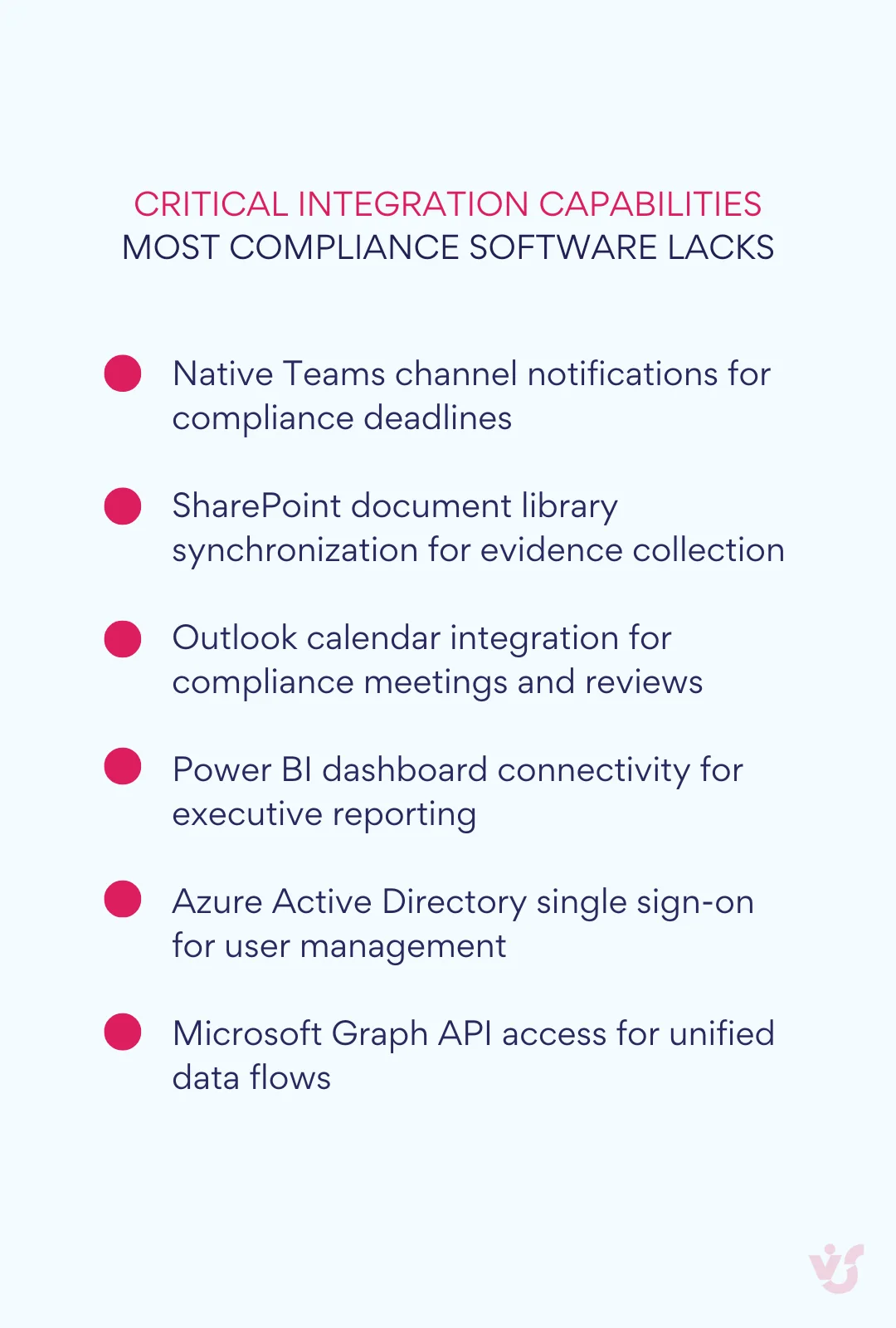
How to Choose the Right Solution
Selecting compliance software often feels like choosing a life partner—you’ll be working together daily for years, so compatibility matters more than flashy features that look impressive in demonstrations but prove irrelevant to your actual needs.
The decision process becomes more manageable when broken into systematic steps that force you to clarify your requirements before getting distracted by vendor presentations and feature comparisons.
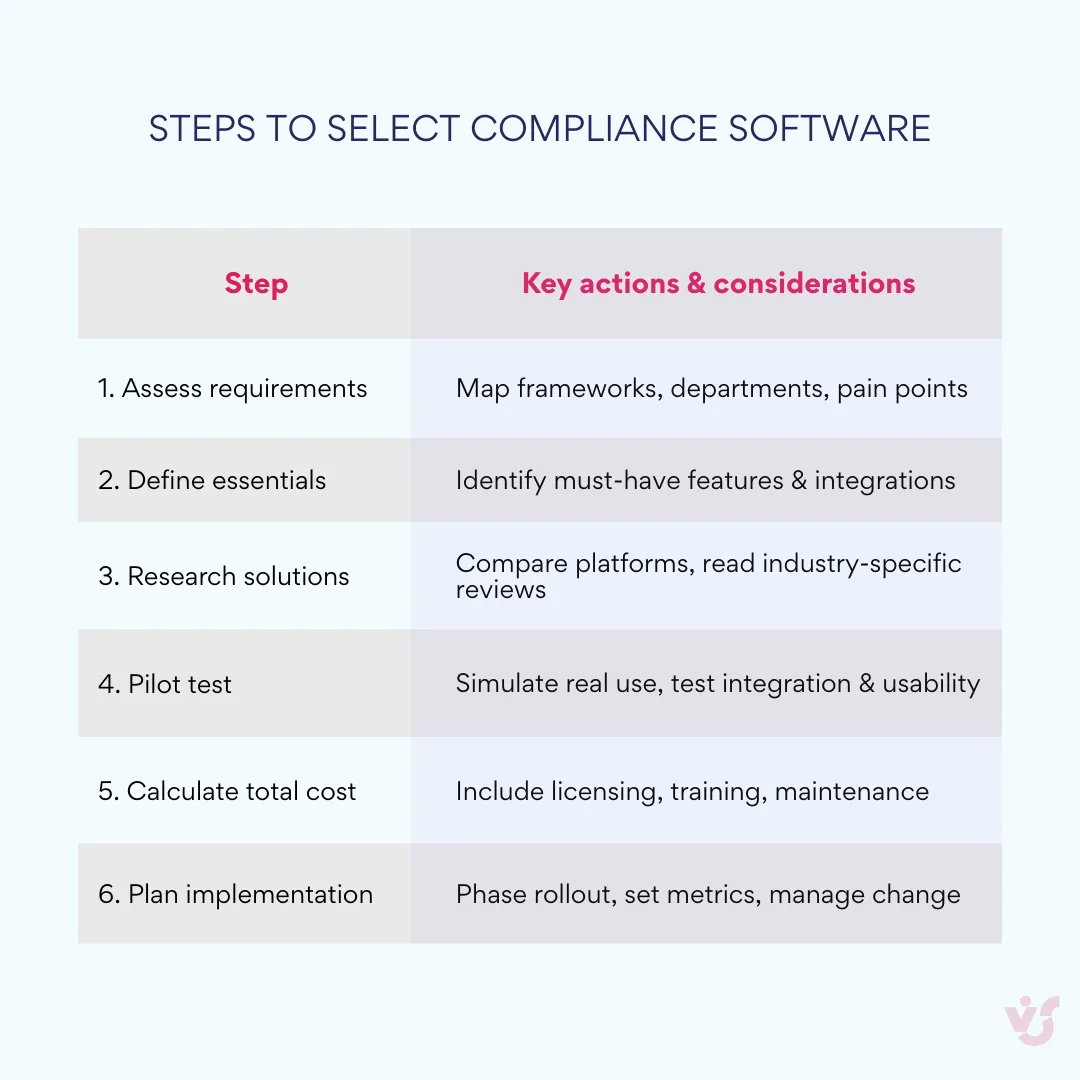
Assess your compliance landscape and organizational scale
Start by mapping your current compliance obligations comprehensively. How many different regulatory frameworks does your organization navigate? A community bank might deal primarily with federal banking regulations and state requirements, while a multinational pharmaceutical company juggles FDA approvals, European Medicines Agency standards, country-specific drug regulations, and various quality certifications.
Count the departments involved in compliance activities. Finance teams handle regulatory reporting, HR manages employment law compliance, IT ensures data security requirements, and operations maintains safety and quality standards. Each department brings different working styles, technical capabilities, and integration needs.
Identify which compliance processes cause the most problems currently. Are missed deadlines your primary concern, or do you struggle more with evidence collection during audits? Perhaps your biggest challenge involves coordinating compliance activities across multiple locations or keeping everyone updated when requirements change.
Document the critical nature of different compliance activities. Some requirements carry severe penalties for non-compliance, while others represent lower-risk administrative obligations. Understanding this hierarchy helps prioritize software features and justify budget allocations.
Define your essential requirements
Transform your compliance challenges into specific software requirements before vendors start showcasing their capabilities. This preparation prevents you from being swayed by impressive features that don’t address your actual problems.
Visual planning tools matter most for organizations managing complex compliance calendars with multiple simultaneous deadlines. If your compliance activities follow predictable patterns—quarterly reports, annual audits, monthly safety reviews—calendar and timeline views become essential.
Integration requirements deserve careful consideration. Organizations heavily invested in Microsoft 365, SAP, or other platform ecosystems need software that works within their existing technical environment. Poor integration leads to manual data entry, synchronization errors, and user resistance.
Notification and reminder capabilities vary significantly between platforms. Some provide basic email alerts, while others offer sophisticated escalation systems with multiple communication channels. Consider your team’s communication preferences and the criticality of different compliance deadlines.
Access control and security requirements depend on the sensitivity of your compliance data and the geographic distribution of your team. Organizations handling personal data or operating in multiple countries need robust permission management and audit trail capabilities.
Reporting needs range from simple status dashboards to complex regulatory submissions. Some platforms excel at internal reporting but struggle with the specific formats that regulators require. Others provide extensive reporting capabilities that may overwhelm smaller organizations.
Research and evaluate potential solutions
Begin your research with platforms that align with your organizational size and industry focus. Enterprise platforms may offer impressive capabilities but prove unnecessarily complex for smaller organizations, while simple task management tools may lack the depth that heavily regulated industries require.
Read user reviews carefully, but focus on organizations similar to yours. A review from a 50-person consulting firm may not reflect the experience of a 5,000-employee hospital system. Look for patterns in feedback rather than individual complaints or praise.
Pay attention to implementation timelines and resource requirements. Some platforms deploy quickly but require extensive ongoing configuration, while others demand significant upfront investment but operate smoothly once implemented.
Technical compatibility deserves thorough investigation before making commitments. Can the platform integrate with your existing systems without expensive custom development? Does it support single sign-on if your organization uses directory services? Will it scale appropriately as your organization grows?
Customer support quality becomes crucial when compliance deadlines approach and systems malfunction. Research the vendor’s support responsiveness, availability across time zones if relevant, and escalation procedures for critical issues.
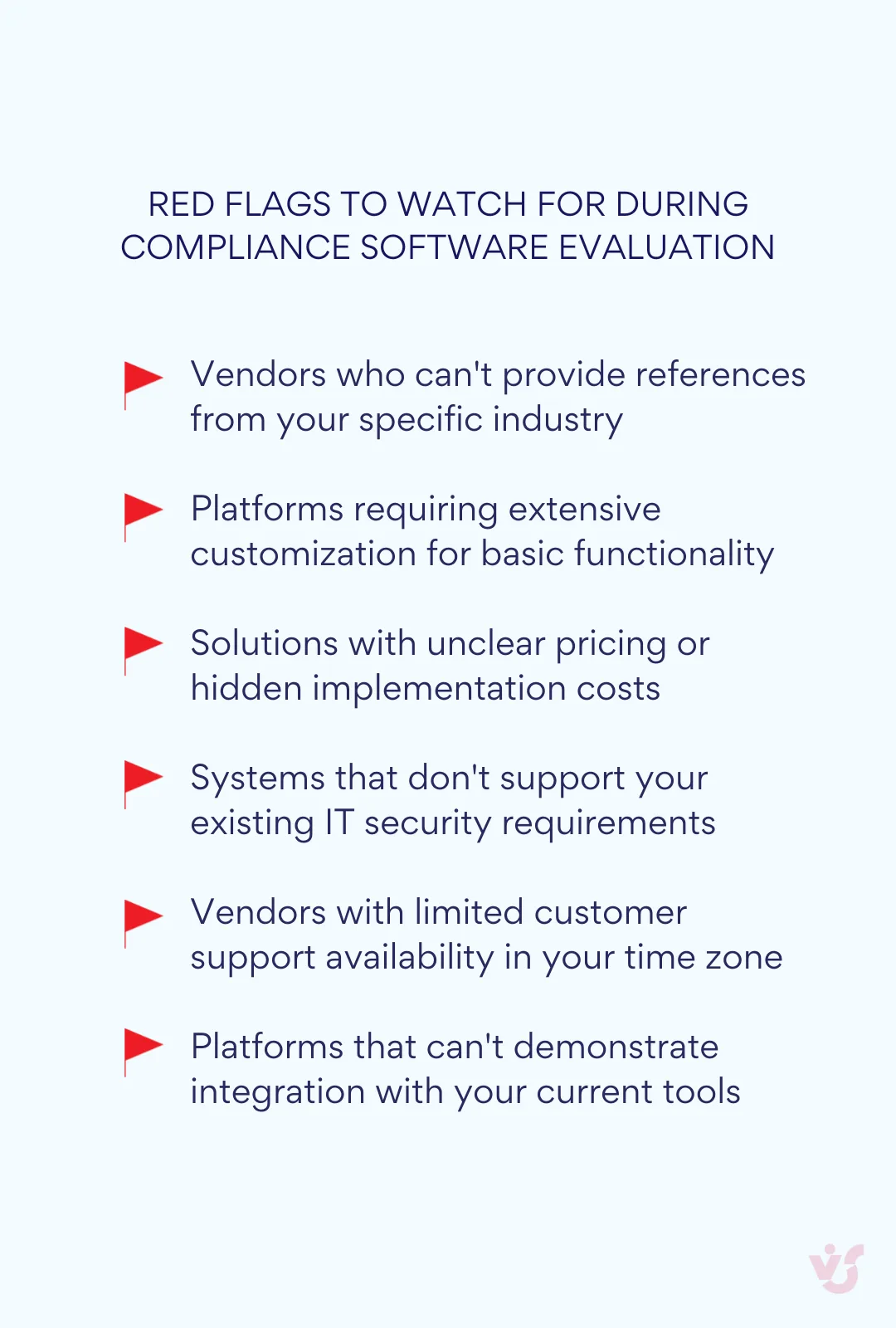
Conduct focused pilot testing
Pilot implementations reveal more about software suitability than any number of demonstrations or reference calls. Structure pilots to test your most challenging compliance scenarios rather than the simple use cases that always work smoothly.
Include representatives from all departments that will use the system in pilot testing. IT staff may love the technical capabilities while end users find the interface confusing, or vice versa. Both perspectives matter for successful implementation.
Test integration capabilities thoroughly during pilots. Data synchronization problems often appear only after extended use, and integration issues that seem minor during demonstrations can become major obstacles in daily operations.
Evaluate the learning curve realistically. How long does it take new users to become productive? Can occasional users navigate the system effectively, or does it require daily use to maintain proficiency?
Measure the impact on compliance process efficiency and accuracy. Does the software actually reduce the time required for compliance activities, or does it simply move work from one place to another? Are users more likely to complete compliance tasks correctly, or does the software introduce new types of errors?
Calculate total cost of ownership
Software licensing represents only one component of compliance solution costs. Factor in implementation services, training, ongoing support, and the internal resources required to maintain the system.
Implementation costs vary dramatically between platforms. Simple cloud solutions may require minimal setup, while enterprise platforms often need months of configuration and process redesign. Some vendors include implementation services in their pricing, others charge separately for professional services.
Training requirements depend on software complexity and user technical sophistication. Intuitive platforms reduce training costs but may lack advanced features, while powerful platforms provide extensive capabilities but require significant user education.
Integration costs often exceed initial estimates, particularly for organizations with complex technical environments. Custom development, data migration, and system synchronization can add substantial expenses to the base software cost.
Ongoing operational costs include support contracts, system administration, and the internal resources needed to maintain compliance processes within the software. Some platforms require dedicated administrators, while others operate effectively with part-time oversight.
Consider scalability in cost calculations. Will pricing increase proportionally as your organization grows, or does the platform offer volume discounts? Can you add users and functionality incrementally, or do licensing models force large upfront commitments?
Make the decision and plan implementation
Once you’ve completed evaluation and pilot testing, resist the temptation to continue researching indefinitely. Perfect compliance software doesn’t exist—every platform involves trade-offs between features, usability, cost, and implementation complexity.
Choose the platform that best addresses your most critical compliance challenges, even if it lacks some desirable features. You can often work around missing capabilities more easily than you can fix fundamental misalignment with your compliance needs.
Plan implementation in phases that deliver value incrementally rather than attempting comprehensive deployment immediately. Start with your most problematic compliance processes or highest-risk requirements, then expand to other areas once the initial implementation proves successful.
Establish success metrics before implementation begins. How will you measure whether the software improves your compliance program? Define specific, measurable improvements you expect to see within three, six, and twelve months.
Prepare for change management challenges that accompany any new system implementation. Users comfortable with existing processes may resist change even when new systems offer clear advantages. Plan communication, training, and support strategies that address these concerns proactively.
Remember that compliance software selection represents the beginning of a long-term relationship, not a one-time purchase decision. Choose vendors that demonstrate commitment to ongoing product development, customer support, and industry expertise that will serve your organization’s evolving needs.
VirtoSoftware Products in Regulatory Compliance Management
Organizations in regulated industries face a persistent challenge that traditional compliance software often overlooks: most employees work primarily within Microsoft 365, yet compliance tasks frequently require switching to separate systems with different interfaces, logins, and workflows. This context switching creates friction that reduces compliance participation and increases the likelihood of missed deadlines.
Explore VirtoSoftware Apps for Compliance Scheduling
Virto Calendar App for Microsoft 365: compliance management where teams already work
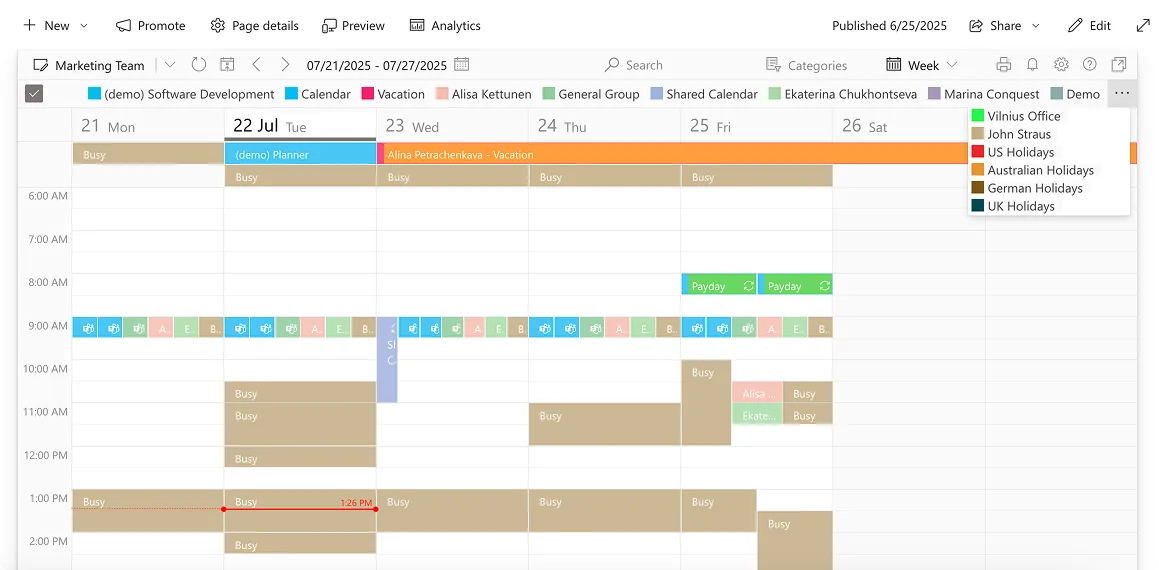
Rather than adding another system to your technology stack, Virto Calendar App integrates regulatory compliance tracking directly into the Microsoft 365 environment where your teams already collaborate. This approach eliminates the adoption barriers that plague standalone compliance solutions.
The platform connects with SharePoint lists to create comprehensive regulatory calendars that track all compliance obligations—from routine quarterly reports to complex multi-stage audit preparations. Teams can see upcoming deadlines, required tasks, and responsible parties without leaving their familiar Microsoft environment.
Core compliance capabilities include:
Automated compliance notifications in Teams channels: Instead of hoping employees check separate compliance systems, important deadlines and reminders appear directly in the Teams channels where work discussions already happen. “Audit deadline in 3 days—upload required documents to the channel” becomes part of the natural workflow rather than an external interruption.
Visual display of regulatory checkpoints and deadlines: Complex compliance schedules become manageable when displayed in familiar calendar formats. Teams can see how different regulatory requirements interact, identify potential conflicts, and plan resources appropriately. The visual approach helps prevent the deadline clustering that often overwhelms compliance teams.
Scalable rights management and centralized oversight: Different team members need different levels of access to compliance information. Some staff need to see only their assigned tasks, while compliance officers require comprehensive oversight capabilities. The platform supports granular permissions while maintaining the collaboration benefits that make Microsoft 365 effective.
Real-time collaboration on compliance tasks: When regulatory requirements change or deadlines shift, updates propagate immediately across all relevant teams. This real-time synchronization prevents the miscommunications that lead to compliance failures in distributed organizations.
Integration with Microsoft Compliance Center
The platform’s technical architecture supports integration with Microsoft Compliance Center APIs, enabling organizations to connect their regulatory obligation tracking with broader compliance monitoring capabilities. This integration allows compliance data to flow between systems without manual intervention, reducing administrative overhead while improving data accuracy.
Addressing the market gap
Current compliance software solutions focus primarily on comprehensive feature sets rather than user adoption and workflow integration. While platforms like LogicGate and MetricStream offer impressive capabilities, they require users to work outside their primary collaboration environments. This separation creates the friction that reduces compliance program effectiveness.
Virto Calendar App addresses this gap by embedding compliance management directly within Microsoft 365, where organizations already handle their daily collaborative work. Teams can manage compliance obligations using the same tools they use for project management, document collaboration, and communication.
Implementation advantages for regulated organizations
Organizations implementing Virto Calendar App for compliance management report several distinct advantages over traditional compliance software:
- Reduced training requirements: Teams already familiar with Microsoft 365 can begin using compliance features immediately without extensive training programs. This familiarity accelerates adoption and reduces implementation costs.
- Higher compliance task completion rates: When compliance activities integrate naturally into existing workflows, completion rates improve significantly. Tasks embedded in Teams channels receive more attention than those buried in separate compliance systems.
- Improved audit preparedness: Having compliance evidence stored within SharePoint and accessible through familiar interfaces makes audit preparation less stressful and more efficient. Auditors can review documentation using standard Microsoft tools rather than learning proprietary systems.
- Better stakeholder communication: Compliance updates shared through Teams channels keep all relevant parties informed without requiring them to monitor separate communication channels or login to additional systems.
Complementary solutions for comprehensive compliance management
Organizations often need additional capabilities beyond calendar-based compliance tracking. Virto offers complementary solutions that work within the same Microsoft 365 environment:
Virto Alerts & Reminders App provides sophisticated notification capabilities that extend beyond basic calendar reminders. The system can monitor SharePoint lists for compliance-related changes, automatically alert responsible parties when deadlines approach, and escalate notifications if required actions remain incomplete. For organizations managing complex compliance workflows, this automated notification system prevents the human errors that cause most compliance failures.
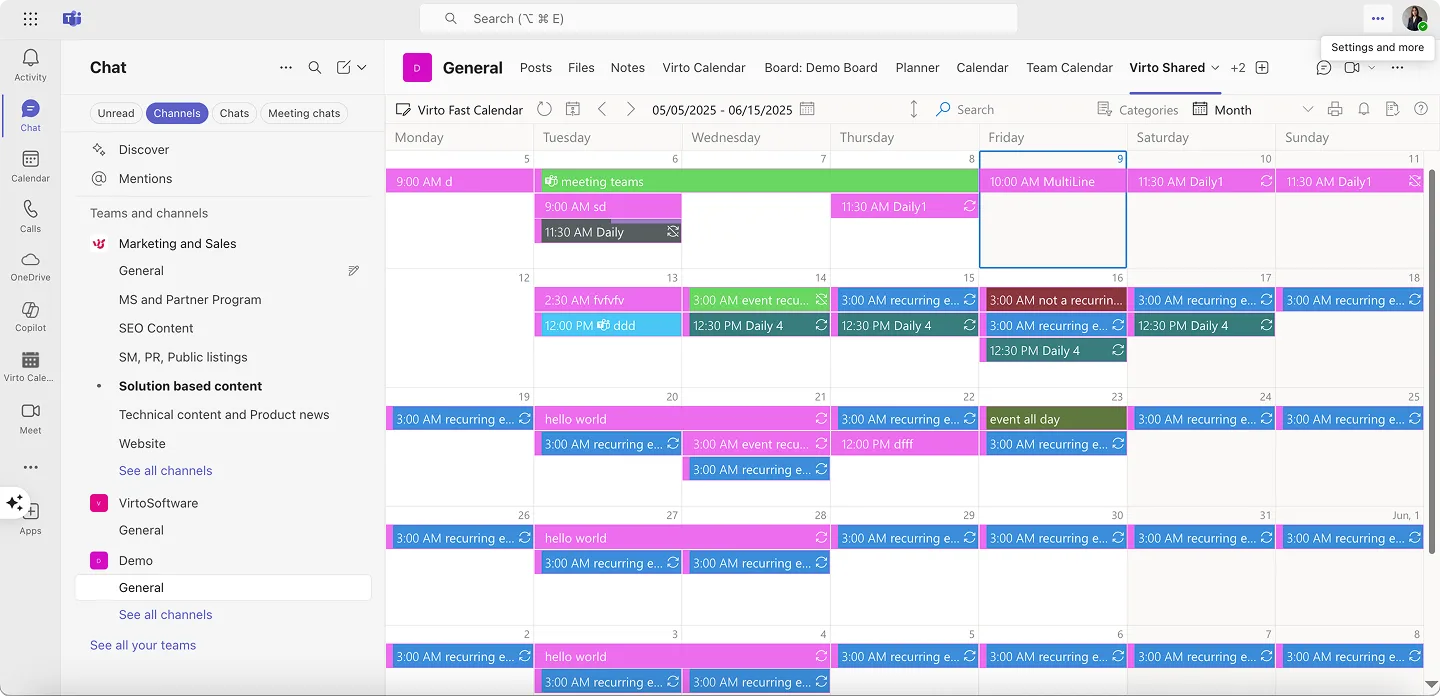
Virto Shared Calendar offers a lightweight alternative for organizations that need simple compliance scheduling without the complexity of comprehensive overlay features. This standalone solution allows teams to create, share, and manage compliance calendars without requiring extensive system integration. The tool works both within Microsoft Teams and as a web application, providing flexibility for organizations with diverse technical environments or external stakeholder involvement.
Both complementary solutions maintain the same design philosophy of working within existing Microsoft 365 workflows rather than requiring users to adopt separate systems. This consistent approach ensures that compliance activities remain integrated with daily work rather than becoming isolated administrative burdens.
Explore VirtoSoftware Use Cases for Compliance Tracking
Conclusion
Regulatory compliance software has evolved from a nice-to-have convenience into an essential operational tool for companies operating in highly regulated environments. The stakes have grown too high and the requirements too complex for organizations to rely on manual tracking systems or fragmented approaches to compliance management.
Modern compliance solutions help organizations systematically manage regulatory requirements while minimizing the risks that come with human error and fragmented processes. They automate the routine work of deadline tracking, notification management, and evidence collection that used to consume significant staff time. Perhaps most importantly, they simplify interactions with auditors by providing the comprehensive documentation and audit trails that regulatory examinations require.
Choosing the right compliance tool extends far beyond operational efficiency—it directly impacts your organization’s ability to avoid regulatory fines, protect its reputation, and maintain uninterrupted business operations. The wrong choice can leave you vulnerable to compliance failures that threaten not just your bottom line, but your ability to operate in your chosen markets.
Most compliance software solutions require users to work outside their primary collaborative environments, creating the adoption barriers and context-switching friction that reduce program effectiveness. Virto Calendar App for Microsoft 365 addresses this fundamental challenge by offering a unique approach to compliance management that works directly within Teams and SharePoint.
This integration enables organizations to track and meet compliance standards through the same platforms where teams already collaborate on daily work. Compliance tasks become part of natural workflows rather than separate administrative burdens, ensuring higher participation rates and more reliable completion of required activities. Real-time compliance monitoring happens where work actually gets done, creating the visibility and accountability that effective compliance programs require.
Ready to see how Virto Calendar App can improve your organization’s compliance management? Schedule a personalized demo or test a pilot integration to experience firsthand how compliance activities integrate naturally with your existing Microsoft 365 workflows.
Explore additional resources to understand how VirtoSoftware solutions address specific compliance challenges:
- Finance and compliance management solutions
- Compliance calendar implementation strategies
- Software tools designed for regulated organizations
Real-world implementation examples:








